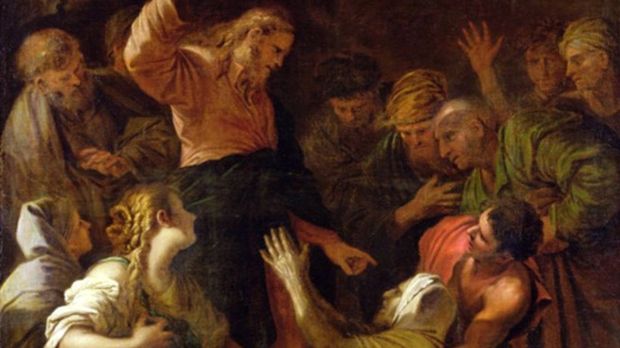Lenten Campaign 2025
This content is free of charge, as are all our articles.
Support us with a donation that is tax-deductible and enable us to continue to reach millions of readers.
A leper comes to Jesus, begging him to make him clean (the Gospel for this Sunday). Moved with pity, Jesus stretched out his hand and touched him, speaking words of healing.
It is stunning to note that, with this episode between Jesus and the leper, we are still in the very first chapter of the Gospel of Mark. Jesus has already proclaimed the arrival of the time of fulfillment, called his first disciples, astonished people by his teaching, cured a demoniac, healed Peter’s sick mother-in-law along with many others who were ill or possessed by demons, and preached the Good News throughout the whole of Galilee. Chapter one of Mark is a kind of movie trailer — a sneak preview — to the whole of Christ’s ministry. It clues us in to how to understand this man. It is a microcosm of Christ’s Messiahship.
For the Living Dead
And the next event — the curing of the leper — is key to it. It is as if Jesus is telling us: Yes, I have come for sinners, for those who have not yet pursued their true vocation, for the ignorant, for the sick, for those tormented by evil. But most of all, I have come for this one: for the person engulfed in affliction and sorrow, overwhelmed with misery, alone and alienated … even from themself. The leper was an outsider like no other, loathed and feared by society, unloved and judged unlovable. The leper faced unrelenting rejection at every moment of life … even from their own body.
The 1st-century historian Josephus states in his writings that a leper was forbidden to “come into the city at all or to live with any others, as if they were in effect dead persons.” The Bible itself refers to lepers this way: the flesh of the leper is “as of one dead” (Numbers 12:12).
But Jesus comes for the living dead.
Jesus Stretched Out his Hand
The Gospel says explicitly that Jesus “stretched out his hand.” It is an archetypal image of rescue, tenderness, self-giving. Jesus stretches out his hand to the water-walking Peter to prevent him from sinking into the sea (Mt 14:31). On Calvary, Jesus will stretch out his hand so that it can be nailed to the cross. Even now the saving reach of the Crucified is extended to the leper.
And even before Jesus speaks to him, the leper experiences in Jesus’ gesture a breakthrough that gives him life.
We can be saved only when he from whom we have cut ourselves off takes the initiative with us and stretches out his hand to us. Only being loved is being saved, and only God’s love can purify damaged human love (Cardinal Ratzinger).
How much we long for this gesture of being saved, of being wanted in our own life. St. Thérèse of Lisieux assures us: “When God stretches out his hand to ask sacrifices of us, his hand is never empty, and his intimate friends can draw from him the courage and strength they need.”
Jesus Touched Him
The Lord does not need to make physical contact with the leper to heal him of his leprosy; he could cure him from a distance, as Jesus does with many others. As Blessed Isaac of Stella comments, “It was for your instruction that divine Wisdom, our Medicine and our Doctrine, chose to heal the leper by touching him, though a word would have sufficed.”
The healing of the leper in its way foreshadows the sacramental ministry of the Church, for each of the seven sacraments entails some form of touch. Jesus heals the leper, not as a physician but, as a Savior:
The reason why Jesus touched the leper, even though the touch was not necessary to the working of the cure, was to show that he gives health, not as a servant, but as the Lord” (St. John Chrysostom).
And it is this touch of God that forms the leper for mission: The man went away and began to publicize the whole matter. “At the touch of God, let us resound with every generous thought, every human affection; let us learn to find in each soul the point at which it is still in touch with God” (Servant of God Elisabeth Leseur).
Jesus Spoke to Him
The words that Jesus speaks to the leper echo wondrously the words Jesus will pray in Gethsemane (Mk 14:36): I do will it.
The tender words of Christ confirm Jesus’ preference for the leper:
Christ laid a brotherly hand upon the loathsome. He regarded the horrors of the entombed and the danger of contact with corrupted flesh as of slighter consequence; and he held the sufferers thus hemmed in by the terrors and repulsion of man as of supreme importance; as of priceless value; as souls unchanged by the encasement of horror. To Christ, the sores are not the man. The abased, humiliated sphere, the infirm consciousness, the blinded sight or half-silenced speech, cover to him the soul for whom he would have suffered death (Rose Hawthorne Lathrop (Mother M. Alphonsa) +1926).
And all this takes place because a leper came to Jesus. Which means that is all we need to do.
~
Find Fr. Peter John Cameron’s reflection on the Sunday Gospel each week here.
Find his series of brief reflections on prayer here.
And his new series on the Eucharist here.


